SYDNEY CBD
SYDNEY CBD
SYDNEY CBD
SYDNEY CBD
SYDNEY CBD
SYDNEY CBD
Smile Concepts is dedicated to helping you smile with new confidence with Gum Disease Treatment in Sydney.

Dr. Manish Shah is a cosmetic dentist with a special interest in porcelain veneers, dental implants and Invisalign in Sydney. He is also a medical doctor with an expertise in sleep & craniofacial pain medicine practising at Smile Concepts.
Gum disease affects most people at some time during their life.
It is usually caused by a build-up of plaque on our teeth.
Plaque is a collection of millions of bacteria that cause an infection around your teeth and gums.
The body fights this infection and destroys the gum tissue and ultimately the bone that supports your gums.
Once the bone is lost you will risk losing your teeth. That is why your oral health is so important! Regular brushing and flossing will decrease the chance of getting periodontal disease. In the meantime, make sure that you brush your teeth twice a day would help support the health of your oral conditions.
SO DO NOT LOSE YOUR TEETH!! Once your teeth are lost, you will face a lot more tooth loss treatments such as dental implants or even all-teeth-on-4.
Luckily, with advanced laser gum disease treatment, we can save your teeth as long as we tackle the cause of the problems.


One of the common signs of gum disease is bleeding gums.
When bacteria produce the toxin that destroys gums, the body responds by sending our own body’s defence cells to attack the toxin.
This leads to collection of fluid under the gums leading to swollen gums.
When the fluid collects under the gums, after the attack from the bacteria and our defence cells, this leads to pressure building up in the tissues.
This process is called inflammation and it could lead to sore gums.
This is also when we would recommend seeing your dentist as soon as possible to give you medical advice on what you can do to get rid of sore and swollen gums.
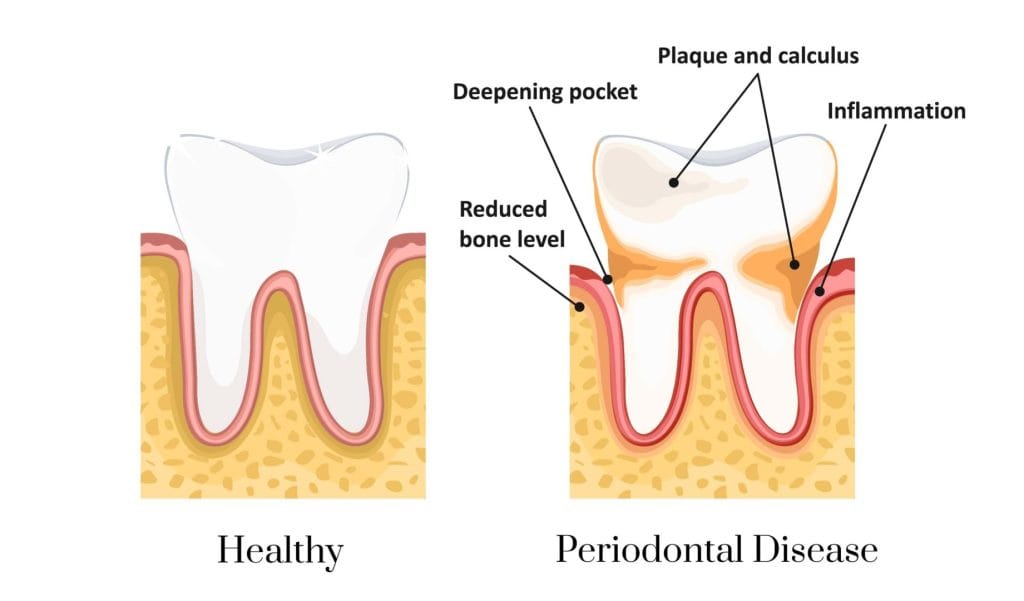
Gum disease evolves with time if warning signs are ignored and your oral health is not being taken care of.
Gingivitis is early gum disease, which occurs when dental plaque is allowed to build up on teeth, and becomes hard ‘calculus’. This happens when your oral health is not done correctly and there’s a lack of brushing and flossing regularly.
This is most common where the gum margin joins the tooth.
The characteristics of gingivitis are bleeding, redness and swelling of the gum, sensitive teeth and gums that bleed easily.
Periodontitis is advanced gum disease that occurs if gingivitis is not treated.
The gum margin that seals to the tooth is weakened, allowing bacteria and their products to cause more inflammation in the structures below the gum margin.
These structures include the covering of the tooth root (cementum), the bone, and the fibres that connect the cementum to the bone (periodontal ligament).
As the disease destroys these structures, spaces form between the tooth and the gum, as the bone is lost.
These spaces are called ‘periodontal pockets’.
Further signs of periodontitis include bleeding, swelling and receding gums together with bad breath, a bad taste in the mouth and loose teeth.
That’s why it is important to get Gum Disease Treatment Sydney as soon as the signs arise and get professional cleaning every 6 months to prevent the gums and teeth from getting these diseases.
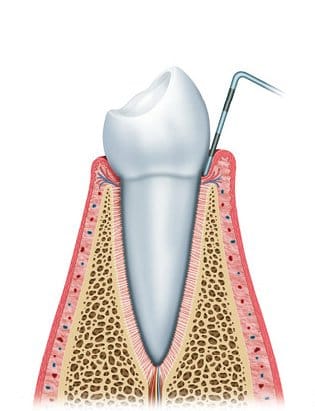
Healthy gums and bone anchor teeth firmly in place. Great Oral hygiene and oral condition.
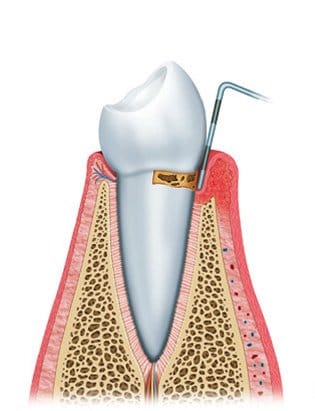
Plaque and its byproducts start to irritate the gums, making them tender, inflamed, and likely to bleed. Gum becomes more sensitive to touch and brush.
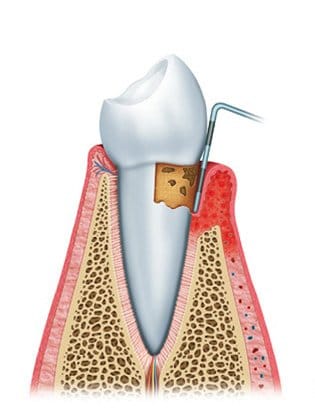
Unremoved, plaque hardens into calculus (tartar).
As Plaque and calculus continue to build up, the gums begin to recede from the teeth, and pockets form from between the teeth and gums. This is a warning sign of advanced periodontitis.
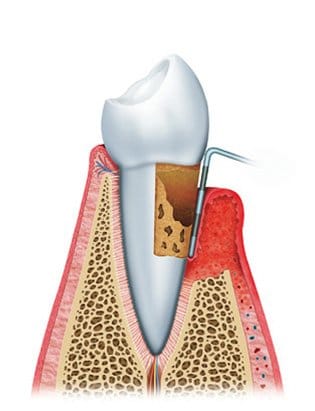
At this stage, the gums recede farther, destroying more bone and the periodontal ligament.
Even healthy teeth may become loose and need to be extracted due to poor oral hygiene and the developement of gum diseases.
The main cause of periodontal disease is bacterial plaque, a sticky, colourless film that constantly forms on your teeth.
Meanwhile, the following risk factors may also affect the oral health of your gums and teeth.

Smoking leads to closure of micro blood vessels that transport essential oxygen to tissues so the gum can heal and survive.
Therefore if these blood vessels are closed then there is no nutrients or oxygen reaching the tissues.
This causes the gum tissue to die and ultimately lead to loss of teeth.
Research proves that up to 30% of the population may be genetically susceptible to gum disease.
Changes in hormones during pregnancy can lead to an increased response to bacteria leading to swelling and bleeding of gums due to hormonal changes. It is always recommended to practice good oral hygiene and help prevent any complications during these periods of time.
As you probably already know, stress is linked to many serious conditions such as hypertension, cancer, and numerous other health problems.
Stress is also a risk factor for periodontal disease.
Some drugs, such as oral contraceptives, anti-depressants, and certain heart medicines, can lead to an increased response to gum disease leading to swelling and bleeding of the gums.
Clenching or grinding your teeth can put excess force on the supporting tissues of the teeth and could speed up the rate at which these periodontal tissues are destroyed.

Diabetes is a disease that causes altered levels of sugar in the blood.
If you are diabetic, you are at higher risk for developing infections, including periodontal diseases.
These infections can impair the ability to process and/or utilize insulin, which may cause your diabetes to be more difficult to control and your infection to be more severe than a non-diabetic.
A diet low in important nutrients can compromise the body’s immune system and make it harder for the body to fight off infection.
Because periodontal disease is a serious infection, poor nutrition can worsen the condition of your gums.
A diet low in important nutrients can compromise the body’s immune system and make it harder for the body to fight off infection.
Because periodontal disease is a serious infection, poor nutrition can worsen the condition of your gums.
Diseases that interfere with the body’s immune system may worsen the condition of the gums.
You should clean your teeth carefully every day with a soft, small headed toothbrush. The area where the gum meets the tooth should also be cleaned to ensure the gum tissue and supporting structure remains healthy. The careful use of dental floss between teeth also assists in removal of plaque. This will prevent the formation of a gum infection. While it is tempting to avoid cleaning your gums when they are inflamed and bleeding, brushing will help improve the situation. Professional scaling and cleaning at Smile Concepts, as part of Gum Disease Treatment Sydney, allows you to keep your smile healthy and disease-free. If you’ve already lost a tooth to gum infection, you may be interested in dental implants the permanent tooth replacement option. If you would like more information on gum disease treatment, gum infection, sore gums or swollen gums, contact Smile Concepts Sydney on 02 9267 7777

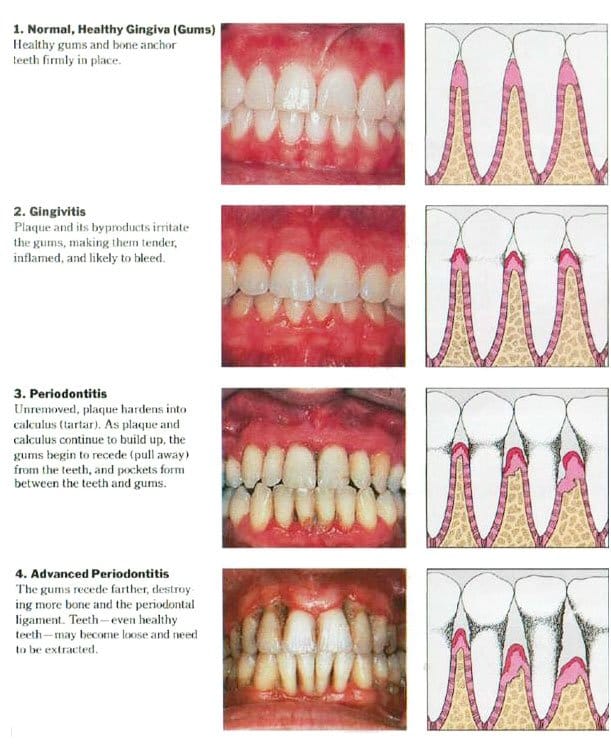
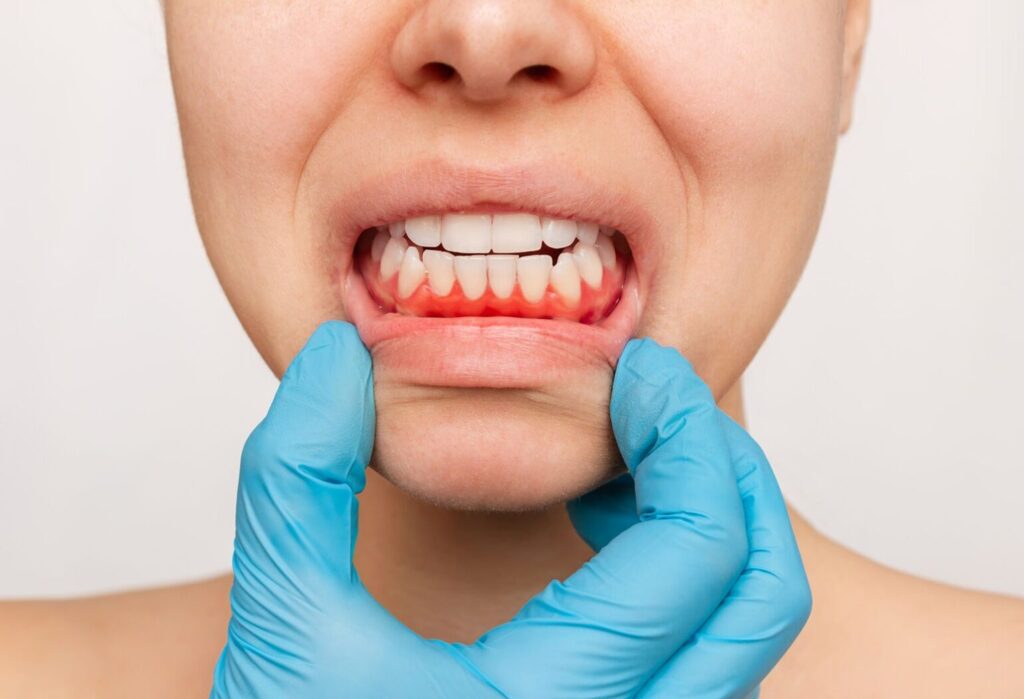
Suffering from gum disease? Let the pro dentists at Smile Concepts take care of your dental needs.
Here at Smile Concepts, we pride ourselves on providing you with the most effective treatment options to suit your needs best.
Your gum health is our priority!
Scaling & Root Planning
As your Sydney dentist, we offer deep cleaning to treat gum disease and prevent inflammation.
Laser Therapy
At Smile Concepts, laser therapy offers precise, minimally invasive treatment with faster healing and reduced pain.
Pocket reduction surgery at Smile Concepts removes bacteria, reduces inflammation, and preserves natural teeth health.
At Smile Concepts, bone grafting restores jawbone health, supporting teeth, and implants, and promoting new bone growth.
Gum grafting covers exposed roots, restores gum tissue, reduces sensitivity, and enhances your smile.
A procedure that replaces gum tissue and jawbone to stabilise teeth and improve oral health.
By utilising the latest technology and expert methods, we focus on efficiently restoring the
health of your gums.
At Smile Concepts, we are dedicated to providing the best care for gum disease.
Here’s why you should choose us:
Trust our expert dentists at Smile Concepts to effectively treat any oral disorder.
Say goodbye to all gum problems!
Our dentists at Smile Concepts will inspect your gums and teeth in detail, including measurements of the depth of your gum pockets and looking for any signs of inflammation. X-rays might also be taken to check the health of your bone structure.
Treatment time will vary depending on the severity of periodontal disease and the treatment option selected. Non-surgical treatments may take one to two visits; surgical treatments may require more follow-up visits.
Most patients experience very little discomfort during scaling and root planing and often we use local anaesthesia. For the more advanced treatment, your comfort is paramount and options such as sedation may be considered.
Most of the following conditions are grounds for considering professional dental cleaning every six months. We may recommend more frequent cleaning in the case of one having contracted gum disease or being at high risk.
Don’t hesitate to reach out to us here at Smile Concepts if you suspect that you have gum disease. The better it will be if the treatment occurs as early as possible, which may prevent further complications in the future.
Feel free to ask now! Our expert team at Smile Concepts is making sure you have the right kind of support and care you need.
Gum disease affects most people at some time during their life.
It is usually caused by a build-up of plaque on our teeth.
Plaque is a collection of millions of bacteria that cause an infection around your teeth and gums.
The body fights this infection and destroys the gum tissue and ultimately the bone that supports your gums.
Once the bone is lost you will risk losing your teeth. That is why your oral health is so important! Regular brushing and flossing will decrease the chance of getting periodontal disease. In the meantime, make sure that you brush your teeth twice a day would help support the health of your oral conditions.
SO DO NOT LOSE YOUR TEETH!! Once your teeth are lost, you will face a lot more tooth loss treatments such as dental implants or even all-teeth-on-4.
Luckily, with advanced laser gum disease treatment, we can save your teeth as long as we tackle the cause of the problems.


One of the common signs of gum disease is bleeding gums.
Gum disease treatment with meticulous cleaning of teeth at least twice a day can help prevent gum disease. It’s worth noting that early gingivitis can be reversed with healthier hygiene practices, such as brushing your teeth regularly. However, if the disease has progressed you need to be seen by us to make sure we can help prevent further destruction.
When bacteria produce the toxin that destroys gums, the body responds by sending our own body’s defence cells to attack the toxin.
This leads to collection of fluid under the gums leading to swollen gums.
When the fluid collects under the gums, after the attack from the bacteria and our defence cells, this leads to pressure building up in the tissues.
This process is called inflammation and it could lead to sore gums.
This is also when we would recommend seeing your dentist as soon as possible to give you medical advice on what you can do to get rid of sore and swollen gums.

Gum disease evolves with time if warning signs are ignored and your oral health is not being taken care of.
Gingivitis is early gum disease, which occurs when dental plaque is allowed to build up on teeth, and becomes hard ‘calculus’. This happens when your oral health is not done correctly and there’s a lack of brushing and flossing regularly.
This is most common where the gum margin joins the tooth.
The characteristics of gingivitis are bleeding, redness and swelling of the gum, sensitive teeth and gums that bleed easily.
Periodontitis is advanced gum disease that occurs if gingivitis is not treated.
The gum margin that seals to the tooth is weakened, allowing bacteria and their products to cause more inflammation in the structures below the gum margin.
These structures include the covering of the tooth root (cementum), the bone, and the fibres that connect the cementum to the bone (periodontal ligament).
As the disease destroys these structures, spaces form between the tooth and the gum, as the bone is lost.
These spaces are called ‘periodontal pockets’.
Further signs of periodontitis include bleeding, swelling and receding gums together with bad breath, a bad taste in the mouth and loose teeth.
That’s why it is important to get Gum Disease Treatment in Sydney as soon as the signs arise and get professional cleaning every 6 months to prevent the gums and teeth from getting these diseases.

Healthy gums and bone anchor teeth firmly in place. Great Oral hygiene and oral condition.

Plaque and its byproducts start to irritate the gums, making them tender, inflamed, and likely to bleed. Gum becomes more sensitive to touch and brush.

Unremoved, plaque hardens into calculus (tartar).
As Plaque and calculus continue to build up, the gums begin to recede from the teeth, and pockets form from between the teeth and gums. This is a warning sign of advanced periodontitis.

At this stage, the gums recede farther, destroying more bone and the periodontal ligament.
Even healthy teeth may become loose and need to be extracted due to poor oral hygiene and the developement of gum diseases.
The main cause of periodontal disease is bacterial plaque, a sticky, colourless film that constantly forms on your teeth.
Meanwhile, the following risk factors may also affect the oral health of your gums and teeth.

Smoking leads to closure of micro blood vessels that transport essential oxygen to tissues so the gum can heal and survive.
Therefore if these blood vessels are closed then there is no nutrients or oxygen reaching the tissues.
This causes the gum tissue to die and ultimately lead to loss of teeth.
Research proves that up to 30% of the population may be genetically susceptible to gum disease.
Changes in hormones during pregnancy can lead to an increased response to bacteria leading to swelling and bleeding of gums due to hormonal changes. It is always recommended to practice good oral hygiene and help prevent any complications during these periods of time.
As you probably already know, stress is linked to many serious conditions such as hypertension, cancer, and numerous other health problems.
Stress is also a risk factor for periodontal disease.
Some drugs, such as oral contraceptives, anti-depressants, and certain heart medicines, can lead to an increased response to gum disease leading to swelling and bleeding of the gums.
Clenching or grinding your teeth can put excess force on the supporting tissues of the teeth and could speed up the rate at which these periodontal tissues are destroyed.

Diabetes is a disease that causes altered levels of sugar in the blood.
If you are diabetic, you are at higher risk for developing infections, including periodontal diseases.
These infections can impair the ability to process and/or utilize insulin, which may cause your diabetes to be more difficult to control and your infection to be more severe than a non-diabetic.
A diet low in important nutrients can compromise the body’s immune system and make it harder for the body to fight off infection.
Because periodontal disease is a serious infection, poor nutrition can worsen the condition of your gums.
A diet low in important nutrients can compromise the body’s immune system and make it harder for the body to fight off infection.
Because periodontal disease is a serious infection, poor nutrition can worsen the condition of your gums.
Diseases that interfere with the body’s immune system may worsen the condition of the gums.
You should clean your teeth carefully every day with a soft, small headed toothbrush.
The area where the gum meets the tooth should also be cleaned to ensure the gum tissue and supporting structure remains healthy.
The careful use of dental floss between teeth also assists in removal of plaque.
This will prevent the formation of a gum infection. While it is tempting to avoid cleaning your gums when they are inflamed and bleeding, brushing will help improve the situation.
Professional scaling and cleaning at Smile Concepts, as part of Gum Disease Treatment in Sydney, allows you to keep your smile healthy and disease-free.
If you’ve already lost a tooth to gum infection, you may be interested in dental implants the permanent tooth replacement option.
If you would like more information on gum disease treatment, gum infection, sore gums or swollen gums, contact Smile Concepts Sydney on 02 8064 9130


A smile can open doors and change lives.
A smile can open doors and change lives.
Be certain that you will get the best treatment & customer experience.
Be assured that our team of experts shall provide you with The Right Choices.
Our philosophy is a commitment to excellence in dental care & service.


Dr. Manish Shah is a cosmetic dentist with a special interest in porcelain veneers, dental implants and Invisalign in Sydney. He is also a medical doctor with an expertise in sleep & craniofacial pain medicine practising at Smile Concepts.







